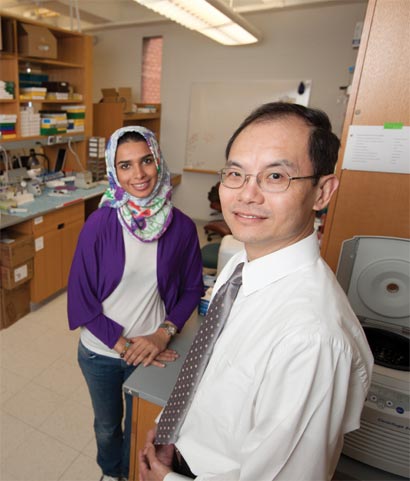Smiles Made from Scratch
Mey Alhabib is on a mission to put the Tooth Fairy out of business.
Alhabib, a post-doctoral student and endodontic resident at the Henry M. Goldman School of Dental Medicine, and her research supervisor, George Huang, the Herbert Schilder Chair in Endodontics and director of the School’s post-doctoral program in endodontics, have begun regenerating two major human tooth components—dental pulp and dentin—using fresh stem cells from baby teeth—which are often tossed after being placed under kids’ pillows—as well as from third molars, or wisdom teeth. Those components could then be used to regrow damaged or decayed parts of a mature tooth, one day eliminating the need for invasive procedures like root canals and dental implants, as well as expensive crowns.

Mey Alhabib and George Huang
“It’s the future of treating clinical diseases,” says Alhabib, who hails from a family of dentists in Saudi Arabia. “The most interesting thing is that you can isolate stem cells from teeth, put them in the culture medium, and freeze them. And they’ll be there for years.” The culture medium is a liquid nutrient that cultivates cell growth.
In a unique procedure, Alhabib harvests dental stem cells from third molars—taken from patients at BU’s Dental Center—and seeds them into a scaffold, a miniature sponge-like carrier. The scaffold is inserted into an extracted human tooth and then implanted into the body of a mouse, which serves as a substitute blood supply for tissue regeneration. After three months, if successful, the tooth is removed from the rodent with the regenerated dentin and dental pulp.
When the technology reaches humans, the scaffold would be implanted directly around the broken or decayed tooth and the empty root canal space would eventually fill with pulp-like tissue, and dentin-like tissue would regrow on the dentinal wall. But that’s years away. The next phase of Huang’s and Alhabib’s research will involve working with the teeth of large animals like pigs.
“We could regrow the lost structure without having to make a big crown, just do some minor patching,” says Huang. “We have data in animals that indicate that it’s a real possibility. Normally, we just discard wisdom teeth and baby teeth. Now we’ll definitely advocate to preserve them.”
Huang says the valuable cells remain viable for about a week after extraction if stored under the right conditions, but are at maximum potency just after they are removed. More dental stem cell banks are opening to meet anticipated demand, he notes. After Alhabib finishes her work at BU, she says, she plans to advance stem cell centers in Saudi Arabia, where she will take a position as an assistant professor in the endodontic department at King Abdulaziz University in Jeddah.
In related research, Huang has successfully reprogrammed dental cells into embryonic-like cells—called induced pluripotent stem (iPS) cells—which may prove an unlimited source for tissue regeneration, and perhaps eventually whole teeth.
Up until now, scientists had been able to create iPS cells from mice or from certain types of human cells such as fibroblasts, which are considered important cellular elements of tissue integrity. But all three types of human dental stem cells Huang and Alhabib tested were easier to reprogram than fibroblasts, previously considered the best way to make human iPS cells. Huang is quick to point out that regrowing a whole tooth from scratch, while being tested in large animals, is still a ways off for humans.
“There’s always new technology replacing old technology,” Huang says. “Nowadays, dental implants are very successful. You get a tooth pulled, you put in an implant. But it took thirty to forty years to get to this stage. Perhaps in the future, we’ll be regrowing a whole tooth, and that may take thirty years, but once the technology is mature, it may replace dental implants.”